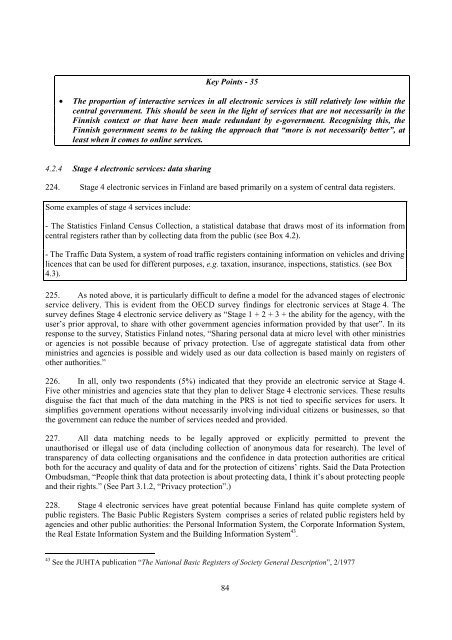e-GOVERNMENT IN FINLAND - ePractice.eu
e-GOVERNMENT IN FINLAND - ePractice.eu
e-GOVERNMENT IN FINLAND - ePractice.eu
You also want an ePaper? Increase the reach of your titles
YUMPU automatically turns print PDFs into web optimized ePapers that Google loves.
Key Points - 35<br />
x The proportion of interactive services in all electronic services is still relatively low within the<br />
central government. This should be seen in the light of services that are not necessarily in the<br />
Finnish context or that have been made redundant by e-government. Recognising this, the<br />
Finnish government seems to be taking the approach that “more is not necessarily better”, at<br />
least when it comes to online services.<br />
4.2.4 Stage 4 electronic services: data sharing<br />
224. Stage 4 electronic services in Finland are based primarily on a system of central data registers.<br />
Some examples of stage 4 services include:<br />
- The Statistics Finland Census Collection, a statistical database that draws most of its information from<br />
central registers rather than by collecting data from the public (see Box 4.2).<br />
- The Traffic Data System, a system of road traffic registers containing information on vehicles and driving<br />
licences that can be used for different purposes, e.g. taxation, insurance, inspections, statistics. (see Box<br />
4.3).<br />
225. As noted above, it is particularly difficult to define a model for the advanced stages of electronic<br />
service delivery. This is evident from the OECD survey findings for electronic services at Stage 4. The<br />
survey defines Stage 4 electronic service delivery as “Stage 1 + 2 + 3 + the ability for the agency, with the<br />
user’s prior approval, to share with other government agencies information provided by that user”. In its<br />
response to the survey, Statistics Finland notes, “Sharing personal data at micro level with other ministries<br />
or agencies is not possible because of privacy protection. Use of aggregate statistical data from other<br />
ministries and agencies is possible and widely used as our data collection is based mainly on registers of<br />
other authorities.”<br />
226. In all, only two respondents (5%) indicated that they provide an electronic service at Stage 4.<br />
Five other ministries and agencies state that they plan to deliver Stage 4 electronic services. These results<br />
disguise the fact that much of the data matching in the PRS is not tied to specific services for users. It<br />
simplifies government operations without necessarily involving individual citizens or businesses, so that<br />
the government can reduce the number of services needed and provided.<br />
227. All data matching needs to be legally approved or explicitly permitted to prevent the<br />
unauthorised or illegal use of data (including collection of anonymous data for research). The level of<br />
transparency of data collecting organisations and the confidence in data protection authorities are critical<br />
both for the accuracy and quality of data and for the protection of citizens’ rights. Said the Data Protection<br />
Ombudsman, “People think that data protection is about protecting data, I think it’s about protecting people<br />
and their rights.” (See Part 3.1.2, “Privacy protection”.)<br />
228. Stage 4 electronic services have great potential because Finland has quite complete system of<br />
public registers. The Basic Public Registers System comprises a series of related public registers held by<br />
agencies and other public authorities: the Personal Information System, the Corporate Information System,<br />
the Real Estate Information System and the Building Information System 43 .<br />
43 See the JUHTA publication “The National Basic Registers of Society General Description”, 2/1977<br />
84
















